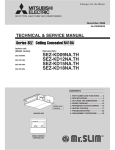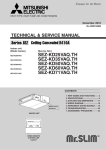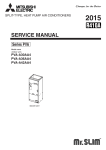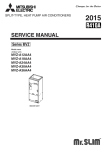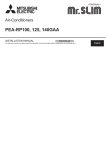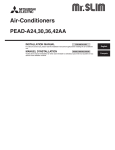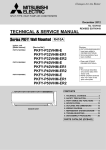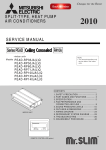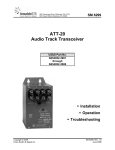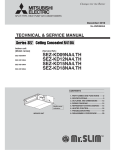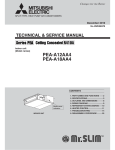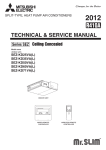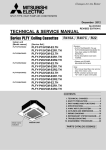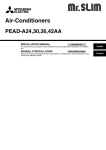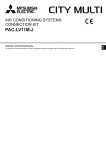Download Mitsubishi Electric PEA-RP140GAA Specifications
Transcript
1 SAFETY PRECAUTION
1-1. ALWAYS OBSERVE FOR SAFETY
Before obtaining access to terminal, all supply
circuits must be disconnected.
1-2. CAUTIONS RELATED TO NEW REFRIGERANT
Cautions for units utilising refrigerant R410A
Use new refrigerant pipes.
Do not use refrigerant other than R410A.
In case of using the existing pipes for R22, be careful with
the followings.
· For RP125 and 140, be sure to perform replacement operation before test run.
· Change flare nut to the one provided with this product.
Use a newly flared pipe.
· Avoid using thin pipes.
If other refrigerant (R22 etc.) is used, chlorine in refrigerant can cause deterioration of refrigerant oil etc.
Use a vacuum pump with a reverse flow check
valve.
Vacuum pump oil may flow back into refrigerant cycle and
that can cause deterioration of refrigerant oil etc.
Make sure that the inside and outside of refrigerant piping is clean and it has no contamination
such as sulfur hazardous for use, oxides, dirt,
shaving particles, etc.
In addition, use pipes with specified thickness.
Use the following tools specifically designed for
use with R410A refrigerant.
The following tools are necessary to use R410A refrigerant.
Gauge manifold
Charge hose
Gas leak detector
Torque wrench
Contamination inside refrigerant piping can cause deterioration of refrigerant oil etc.
Tools for R410A
Flare tool
Size adjustment gauge
Vacuum pump adaptor
Electronic refrigerant
charging scale
Store the piping to be used indoors during
installation and both ends of the piping sealed
until just before brazing. (Leave elbow joints, etc.
in their packaging.)
Handle tools with care.
If dirt, dust or moisture enters into refrigerant cycle, that can
cause deterioration of refrigerant oil or malfunction of compressor.
If dirt, dust or moisture enters into refrigerant cycle, that can
cause deterioration of refrigerant oil or malfunction of compressor.
Use ester oil, ether oil or alkylbenzene oil (small
amount) as the refrigerant oil applied to flares
and flange connections.
Do not use a charging cylinder.
If a charging cylinder is used, the composition of refrigerant will change and the efficiency will be lowered.
If large amount of mineral oil enters, that can cause deterioration of refrigerant oil etc.
Ventilate the room if refrigerant leaks during
operation. If refrigerant comes into contact with
a flame, poisonous gases will be released.
Charge refrigerant from liquid phase of gas
cylinder.
If the refrigerant is charged from gas phase, composition
change may occur in refrigerant and the efficiency will be
lowered.
[1] Cautions for service
(1) Perform service after recovering the refrigerant left in unit completely.
(2) Do not release refrigerant in the air.
(3) After completing service, charge the cycle with specified amount of refrigerant.
(4) When performing service, install a filter drier simultaneously.
Be sure to use a filter drier for new refrigerant.
[2] Additional refrigerant charge
When charging directly from cylinder
· Check that cylinder for R410A on the market is syphon type.
· Charging should be performed with the cylinder of syphon stood vertically. (Refrigerant is charged from liquid phase.)
2
Unit
Gravimeter
[3] Service tools
Use the below service tools as exclusive tools for R410A refrigerant.
No.
1
Tool name
Specifications
Gauge manifold
· Only for R410A
· Use the existing fitting specifications. (UNF1/2)
· Use high-tension side pressure of 5.3MPa·G or over.
2
Charge hose
· Only for R410A
· Use pressure performance of 5.09MPa·G or over.
3
Electronic scale
4
Gas leak detector
· Use the detector for R134a, R407C or R410A.
5
Adaptor for reverse flow check
· Attach on vacuum pump.
6
Refrigerant charge base
7
Refrigerant cylinder
· Only for R410A
· Top of cylinder (Pink)
· Cylinder with syphon
8
Refrigerant recovery equipment
2 PART NAMES AND FUNCTIONS
• Indoor Unit
Air intake (sucks the air inside
the room into the unit)
Air outlet
In case of rear inlet
3
Wired remote controller (option)
Wired remote controller function
* The functions which can be used are restricted according to the model.
: Supported
PAR-30MAA/PAR-31MAA
Function
Slim
Product size H ✕ W ✕ D (mm)
Body
LCD
: Unsupported
PAR-21MAA
City multi
120 ✕ 120 ✕ 19
120 ✕ 130 ✕ 19
Full Dot LCD
Partial Dot LCD
Backlight
Energy-saving
Energy-saving operation schedule
Restriction
Setting the temperature range restriction
Function
Operation lock function
Automatic return to the preset temperature
Weekly timer
On / Off timer
High Power
Manual vane angle
The functions of the function buttons change depending on
the screen. Refer to the button function guide that appears
at the bottom of the LCD for the functions they serve on a
given screen.
When the system is centrally controlled, the button function
guide that corresponds to the locked button will not appear.
<Main display>
Function buttons
F1
F2
F3
<Main menu>
Function guide
F4
ON / OFF lamp
ON / OFF button
This lamp lights up in green while the unit is in operation.
It blinks while the remote controller is starting up or when
there is an error.
Press to turn ON/OFF the indoor unit.
SELECT button
Press to save the setting.
Function button F1
Main display : Press to change the operation mode.
Main menu : Press to move the cursor down.
RETURN button
Press to return to the previous screen.
Function button F2
MENU button
Main display : Press to decrease temperature.
Main menu : Press to move the cursor up.
Press to bring up the Main menu.
Backlit LCD
Function button F3
Operation settings will appear.
When the backlight is off, pressing any button turns the
backlight on and it will stay lit for a certain period of time
depending on the screen.
Main display : Press to increase temperature.
Main menu : Press to go to the previous page.
Function button F4
Main display : Press to change the fan speed.
Main menu : Press to go to the next page.
When the backlight is off, pressing any button turns
the backlight on and does not perform its function.
(except for the
(ON / OFF) button)
4
The main display can be displayed in two different modes: "Full" and "Basic".
The initial setting is "Full". To switch to the "Basic" mode, change the setting on the Main display setting.
<Full mode>
<Basic mode>
* All icons are displayed for explanation.
Operation mode
Indoor unit operation mode appears here.
Appears when the buttons are locked.
Preset temperature
Preset temperature appears here.
Appears when the On/Off timer or Night setback function is
enabled.
Clock (See the Installation Manual.)
Current time appears here.
Fan speed
Appears when the Weekly timer is enabled.
Fan speed setting appears here.
Button function guide
Appears while the units are operated in the energy-save
mode.
Functions of the corresponding buttons appear here.
Appears when the ON/OFF operation is centrally controlled.
Appears when the operation mode is centrally controlled.
Appears when the preset temperature is centrally controlled.
Indicates the vane setting.
Indicates the louver setting.
Room temperature
(See the Installation Manual.)
Indicates the ventilation setting.
Current room temperature appears here.
Appears when the preset temperature range is restricted.
Most settings (except ON / OFF, mode, fan speed, temperature) can be made from the Menu screen.
5
Menu structure
Main menu
Press the MENU button.
Move the cursor to the desired item with the
F1
and
F2
buttons, and press the SELECT button.
Vane · Louver · Vent. (Lossnay)
High power
Timer
On / Off timer
Auto-Off timer
Filter information
Error information
Weekly timer
Energy saving
Auto return
Schedule
Night setback
Restriction
Temp. range
Operation lock
Maintenance
Auto descending panel
Manual vane angle
Initial setting
Main / Sub
Clock
Main display
Contrast
Display details
Auto mode
Administrator password
Language selection
Service
Service menu
Test run
Drain pump test run
Input maintenance info.
Function setting
Lossnay (City Multi only)
Check
Self check
Maintenance password
Remote controller check
Not all functions are available on all models of indoor units.
6
Main menu list
Setting and display items
Vane · Louver · Vent.
(Lossnay)
Setting details
Use to set the vane angle.
Use to turn ON / OFF the louver.
Select a desired setting from "ON" and "OFF."
Use to set the amount of ventilation.
Select a desired setting from "Off," "Low," and "High."
High power
Timer
Use to reach the comfortable room temperature quickly.
Units can be operated in the High-power mode for up to 30 minutes.
On/Off timer
Use to set the operation On/Off times.
Time can be set in 5-minute increments.
* Clock setting is required.
Auto-Off
timer
Use to set the Auto-Off time.
Time can be set to a value from 30 to 240 in 10-minute increments.
Filter information
Error information
Use to check error information when an error occurs.
Error code, error source, refrigerant address, unit model, manufacturing number, contact
information (dealer's phone number) can be displayed.
* The unit model, manufacturing number, and contact information need to be registered in
advance to be displayed.
Weekly timer
Use to set the weekly operation On / Off times.
Up to eight operation patterns can be set for each day.
* Clock setting is required.
* Not valid when the On/Off timer is enabled.
Energy
saving
Auto return
Use to get the units to operate at the preset temperature after performing energy-save
Time can be set to a value from 30 and 120 in 10-minute increments.
* This function will not be valid when the preset temperature ranges are restricted.
Schedule
Night setback
Restriction
Set the start/stop times to operate the units in the energy-save mode for each day of the
week, and set the energy-saving rate.
Up to four energy-save operation patterns can be set for each day.
Time can be set in 5-minute increments.
Energy-saving rate can be set to a value from 0% or 50 to 90% in 10% increments.
* Clock setting is required.
Use to make Night setback settings.
Select "Yes" to enable the setting, and "No" to disable the setting. The temperature range and
the start/stop times can be set.
* Clock setting is required.
Temp. range Use to restrict the preset temperature range.
Different temperature ranges can be set for different operation modes.
Operation
lock
Maintenance Auto
descending
panel
Use to lock selected functions.
The locked functions cannot be operated.
Auto descending panel (Optional parts) Up / Down you can do.
Manual
vane angle
Initial setting Main/Sub
When connecting two remote controllers, one of them needs to be designated as a sub
controller.
Clock
Use to set the current time.
Main display
Use to switch between "Full" and "Basic" modes for the Main display.
The initial setting is "Full."
Contrast
Use to adjust screen contrast.
7
Setting and display items
Initial setting Display
details
Auto mode
Setting details
Make the settings for the remote controller related items as necessary.
Clock: The initial settings are "Yes" and "24h" format.
Temperature: Set either Celsius (˚C) or Fahrenheit (˚F).
Room temp. : Set Show or Hide.
Auto mode: Set the Auto mode display or Only Auto display.
Whether or not to use the AUTO mode can be selected by using the button.
This setting is valid only when indoor units with the AUTO mode function are connected.
Administrator The administrator password is required to make the settings for the following items.
password
Timer setting Energy-save setting Weekly timer setting
Restriction setting Outdoor unit silent mode setting Night set back
Service
Language
selection
Test run
Use to select the desired language.
Select "Test run" from the Service menu to bring up the Test run menu.
Test run Drain pump test run
Input
Select "Input maintenance Info." from the Service menu to bring up the Maintenance
maintenance information screen.
The following settings can be made from the Maintenance Information screen.
Model name input Serial No. input Dealer information input
Function
Make the settings for the indoor unit functions via the remote controller as necessary.
setting
This setting is required only when the operation of City Multi units is interlocked with
LOSSNAY
LOSSNAY units.
setting
(City Multi only)
Check
Error history: Display the error history and execute delete error history.
Refrigerant leak check: Refrigerant leaks can be judged.
Smooth maintenance: The indoor and outdoor maintenance data can be displayed.
Request cord: Details of the operation data including each thermistor temperature and error
history can be checked.
Self check
Error history of each unit can be checked via the remote controller.
Maintenance Take the following steps to change the maintenance password.
password
Remote
When the remote controller does not work properly, use the remote controller checking
controller
function to troublushoot the problem.
check
8
Wireless remote controller (option)
●
Operation buttons
CHECK TEST RUN
MODEL SELECT
ON/OFF button
SET TEMPERATURE button
SET TEMPERATURE button sets and
any desired room temperature.
Pushing button starts operation.
Pushing again stops operation.
NOT AVAILABLE
FAN SPEED button
TEMP
ON/OFF
AUTO STOP/AUTO START button
Used for selecting timed starting or stopping.
This button is used to set fan speed to
low, medium or high.
FAN AUTO STOP
MODE SELECT button
This button is used to change between
auto, cooling, heating and drying operation modes.
MODE VANE AUTO START
CHECK LOUVER
h
CHECK button
TEST RUN
min
VANE CONTROL button
Used to change the airflow direction.
h button
Used for setting the current time.
TEST RUN button
SET RESET CLOCK
min button
Used for setting the current time.
LOUVER button
Used for adjusting the airflow direction.
● When using the wireless remote controller, point it towards the receiver on
the indoor unit.
● If the remote controller is operated within approximately two minutes after
power is supplied to the indoor unit, the indoor unit may beep twice as the
unit is performing the initial automatic check.
● The indoor unit beeps to confirm that the signal transmitted from the
remote controller has been received. Signals can be received up to
approximately 7 meters in a direct line from the indoor unit in an area 45°
to the left and right of the unit. However, illumination such as fluorescent
lights and strong light can affect the ability of the indoor unit to receive signals.
● If the operation lamp near the receiver on the indoor unit is flashing, the
unit needs to be inspected. Consult your dealer for service.
● Handle the remote controller carefully. Do not drop the remote controller or
subject it to strong shocks. In addition, do not get the remote controller
wet or leave it in a location with high humidity.
● To avoid misplacing the remote controller, install the holder included with
the remote controller on a wall and be sure to always place the remote
controller in the holder after use.
Battery installation/replacement
1. Remove the top cover, insert two AAA
batteries, and then install the top cover.
1
3
Top cover
2
Two AAA batteries
Insert the negative (–)
end of each battery
first. Install the batteries in the correct directions (+, –).
2. Press the Reset button.
Press the Reset button
with an object that has
a narrow end.
9
3 SPECIFICATION
PEA-RP100GAA
INDOOR UNIT
Service Ref.
Mode
Power supply
Input
Running Current
External finish
Heat exchanger
Fan (drive) × No.
Fan
Fan motor output
Airflow
50Pa
(Low-High)
100Pa
150Pa
External static pressure
Booster heater
Operation control & Thermostat
50Pa
Sound pressure level
(Low-High)
100Pa
150Pa
Field drain pipe O.D
Dimensions
W
D
H
Weight
kW
Cooling, Heating
Single phase, 50Hz, 220-240V
0.21
1.83
Galvanized sheets
Plate fin coil
Sirocco fan × 2
0.249
m3/min (L/S)
34-42 (560-700)
Pa
kW
50-100-150
Remote controller & built-in
39-42
42-45
44-48
25.4 (1)
1400 (55-1/8)
634 (25)
400 (15-3/4)
63
139
kW
A
dB (A)
mm (in.)
mm (in.)
mm (in.)
mm (in.)
kg
lbs
PEA-RP125GAA
INDOOR UNIT
Service Ref.
Mode
Power supply
Input
Running Current
External finish
Heat exchanger
Fan (drive) × No.
Fan
Fan motor output
Airflow
50Pa
(Low-High)
100Pa
150Pa
External static pressure
Booster heater
Operation control & Thermostat
50Pa
Sound pressure level
(Low-High)
100Pa
150Pa
Field drain pipe O.D
Dimensions
W
D
H
Weight
Cooling, Heating
Single phase, 50Hz, 220-240V
0.49
3.84
Galvanized sheets
Plate fin coil
Sirocco fan × 2
0.249
48-60 (800-1000)
43-54 (716-900)
41-52 (683-866)
50-100-150
Remote controller & built-in
42-45
43-47
45-49
25.4 (1)
1400 (55-1/8)
634 (25)
400 (15-3/4)
63
139
kW
A
kW
m3/min (L/S)
Pa
kW
dB (A)
mm (in.)
mm (in.)
mm (in.)
mm (in.)
kg
lbs
PEA-RP140GAA
INDOOR UNIT
Service Ref.
Mode
Power supply
Input
Running Current
External finish
Heat exchanger
Fan (drive) × No.
Fan
Fan motor output
Airflow
50Pa
(Low-High)
100Pa
150Pa
External static pressure
Booster heater
Operation control & Thermostat
50Pa
Sound pressure level
(Low-High)
100Pa
150Pa
Field drain pipe O.D
Dimensions
W
D
H
Weight
Cooling, Heating
Single phase, 50Hz, 220-240V
0.49
3.84
Galvanized sheets
Plate fin coil
Sirocco fan × 2
0.249
48-60 (800-1000)
43-54 (716-900)
41-52 (683-866)
50-100-150
Remote controller & built-in
42-45
43-47
45-49
25.4 (1)
1400 (55-1/8)
634 (25)
400 (15-3/4)
63
139
kW
A
kW
m3/min (L/S)
Pa
kW
dB (A)
mm (in.)
mm (in.)
mm (in.)
mm (in.)
kg
lbs
10
4 FAN PERFORMANCE AND CORRECTED AIR FLOW
PEA-RP100GAA
(External static pressure 50Pa) 220-240V 50Hz
80
70
60
External static pressure (Pa)
High
50
40
Low
30
20
10
0
25
30
35
40
Airflow rate(m3/min)
45
50
45
50
PEA-RP100GAA
(External static pressure 100Pa) 220-240V 50Hz
140
120
High
External static pressure (Pa)
100
80
Low
60
40
20
0
25
30
35
40
Airflow rate(m3/min)
PEA-RP100GAA
(External static pressure 150Pa) 220-240V 50Hz
200
180
160
High
External static pressure (Pa)
140
120
Low
100
80
60
40
20
0
25
30
35
40
Airflow rate(m3/min)
45
50
11
PEA-RP125GAA
(External static pressure 50Pa) 220-240V 50Hz
80
70
High
External static pressure (Pa)
60
50
40
Low
30
20
10
0
35
40
45
50
Airflow rate(m3/min)
55
60
65
60
65
60
65
PEA-RP125GAA
(External static pressure 100Pa) 220-240V 50Hz
140
120
External static pressure (Pa)
100
High
80
60
Low
40
20
0
35
40
45
50
Airflow rate(m3/min)
55
PEA-RP125GAA
(External static pressure 150Pa) 220-240V 50Hz
200
180
160
High
External static pressure (Pa)
140
120
100
80
Low
60
40
20
0
35
40
45
50
Airflow rate(m3/min)
55
12
PEA-RP140GAA
(External static pressure 50Pa) 220-240V 50Hz
80
70
High
External static pressure (Pa)
60
50
40
Low
30
20
10
0
35
40
45
50
Airflow rate(m3/min)
55
60
65
60
65
60
65
PEA-RP140GAA
(External static pressure 100Pa) 220-240V 50Hz
140
120
External static pressure (Pa)
100
High
80
60
Low
40
20
0
35
40
45
50
Airflow rate(m3/min)
55
PEA-RP140GAA
(External static pressure 150Pa) 220-240V 50Hz
200
180
160
High
External static pressure (Pa)
140
120
100
80
Low
60
40
20
0
35
40
45
50
Airflow rate(m3/min)
55
13
5 SOUND PRESSURE LEVELS
5-1. Sound pressure level
Ceiling concealed
Aux. duct
test unit
1.5m
2m
1m
Measurement location
14
5-2. NC curves
PEA-RP100GAA
(External static pressure 50Pa)
70.0
High
Low
65.0
60.0
NC-60
55.0
50.0
NC-50
45.0
40.0
NC-40
35.0
30.0
NC-30
25.0
20.0
NC-20
15.0
Approximate minimum
audible limit on
continuous noise
10.0
5.0
0.0
63
125
250
500
1k
2k
Octave band center frequencies (Hz)
4k
8k
(External static pressure 100Pa)
70.0
High
Low
65.0
60.0
NC-60
55.0
50.0
NC-50
45.0
40.0
NC-40
35.0
30.0
NC-30
25.0
20.0
NC-20
15.0
10.0
Approximate minimum
audible limit on
continuous noise
5.0
0.0
63
125
250
500
1k
2k
Octave band center frequencies (Hz)
4k
8k
(External static pressure 150Pa)
70.0
High
Low
65.0
60.0
NC-60
55.0
50.0
NC-50
45.0
40.0
NC-40
35.0
30.0
NC-30
25.0
20.0
NC-20
15.0
10.0
Approximate minimum
audible limit on
continuous noise
5.0
0.0
63
125
250
500
1k
2k
Octave band center frequencies (Hz)
4k
8k
15
PEA-RP125GAA
(External static pressure 50Pa)
70.0
High
Low
65.0
60.0
NC-60
55.0
50.0
NC-50
45.0
40.0
NC-40
35.0
30.0
NC-30
25.0
20.0
NC-20
15.0
Approximate minimum
audible limit on
continuous noise
10.0
5.0
0.0
63
125
250
500
1k
2k
Octave band center frequencies (Hz)
4k
8k
(External static pressure 100Pa)
70.0
High
Low
65.0
60.0
NC-60
55.0
50.0
NC-50
45.0
40.0
NC-40
35.0
30.0
NC-30
25.0
20.0
NC-20
15.0
Approximate minimum
audible limit on
continuous noise
10.0
5.0
0.0
63
125
250
500
1k
2k
Octave band center frequencies (Hz)
4k
8k
(External static pressure 150Pa)
70.0
High
Low
65.0
60.0
NC-60
55.0
50.0
NC-50
45.0
40.0
NC-40
35.0
30.0
NC-30
25.0
20.0
NC-20
15.0
Approximate minimum
audible limit on
continuous noise
10.0
5.0
0.0
63
125
250
500
1k
2k
Octave band center frequencies (Hz)
4k
8k
16
PEA-RP140GAA
(External static pressure 50Pa)
70.0
High
Low
65.0
60.0
NC-60
55.0
50.0
NC-50
45.0
40.0
NC-40
35.0
30.0
NC-30
25.0
20.0
NC-20
15.0
Approximate minimum
audible limit on
continuous noise
10.0
5.0
0.0
63
125
250
500
1k
2k
Octave band center frequencies (Hz)
4k
8k
(External static pressure 100Pa)
70.0
High
Low
65.0
60.0
NC-60
55.0
50.0
NC-50
45.0
40.0
NC-40
35.0
30.0
NC-30
25.0
20.0
NC-20
15.0
Approximate minimum
audible limit on
continuous noise
10.0
5.0
0.0
63
125
250
500
1k
2k
Octave band center frequencies (Hz)
4k
8k
(External static pressure 150Pa)
70.0
High
Low
65.0
60.0
NC-60
55.0
50.0
NC-50
45.0
40.0
NC-40
35.0
30.0
NC-30
25.0
20.0
NC-20
15.0
Approximate minimum
audible limit on
continuous noise
10.0
5.0
0.0
63
125
250
500
1k
2k
Octave band center frequencies (Hz)
4k
8k
17
22
Refrigerant pipe
flare conection (Liquid)
ø9.52
Drain R1
Return air
Refrigerant pipe
flare conection (Gas)
ø15.88
43
Return air sensor
2x3-ø3 Holes
A
39
50
10
634
530
565
158
54
Left side view
Terminal block
<Outdoor unit connection wiring>
42
Supply air
40
4-ø12 Holes
<For hanging bolt M10>
[Field supply]
20
78
2x9-ø3 Holes
Control box
2x3-ø3.1 Holes
10
Terminal block
<Remote controller wiring>
73
262
A
24
376
Knockout hole ø27
<Outdoor unit connection wiring>
25
100 100
488
21
400
10
234
70.5
125
31
130
130
Front view
1284
1400
1340
1260
921
Top view
130x6=780
2x7-ø3.1 Holes
1300
1102
130x8=1040
Supply air
duct flange
20
Return air
duct flange
199
200
131
Knockout hole ø27
<Remote controller wiring>
144
89
145
330
130
130
95
250
18
11
<Accessory>
·Pipe cover························2pcs.
(For dew condensation prevention of
local piping and unit connection.)
6 OUTLINES & DIMENSIONS
INDOOR UNIT
PEA-RP100, 125, 140GAA
Intake air
Min.500mm
Ceiling
Electric box
Fig.1
Access door 2
Ceiling beam
Min.500mm
0~150
0~150
Drain pan
400
Supply air
1304
Access door 2
(450x450)
Fig.3 (Viewed from the direction of the arrow B)
425
Intake air
Bottom of indoor unit
Electric box
Access door 1
Access door 2
Ceiling
B
1 When connecting inlet duct.
2 When installing the suspension fixtures prior to
installation of the indoor unit without inlet duct.
3 When hanging the indoor unit directly without inlet duct.
Fig.2
Electric box
Maintenance access space
Access door 1
(450x450)
Supply air
400
25
75
200
(2) When a space of less than 500mm is available below the unit between the unit and the ceiling.
(At least 300mm of space should be left below the unit as shown in Fig.4.)
· Create access door 3 below the electric box and the unit as shown in Fig.6.
2
3
1
Intake air
Min.300mm
Ceiling
Electric box
Fig.4
Electric box
Access door 3
Ceiling beam
Supply air
75
25
400
Min.300mm
(1) When a space of 500mm or more is available below the unit between the unit and the ceiling. (Fig.1)
· Create access door 1 and 2 (450x450mm each) as shown in Fig.3.
(Access door 2 is not required if enough space is available below the unit for a maintenance worker to work in.)
· An access hole of the same size as the access door 3 as shown in Fig. 6 is required to access drain pan or heat exchanger for replacement.
(Required only when the ceiling material cannot be removed)
Drain pan
400
Fig.6
1304
Maintenance access space
Access door 3
(Viewed from the direction of the arrow C)
1754
Intake air
Bottom of indoor unit
Supply air
Fig.5
Access door 3
Ceiling
C
1 When connecting inlet duct.
2 When installing the suspension fixtures prior to
installation of the indoor unit without inlet duct.
3 When hanging the indoor unit directly without inlet duct.
Electric box
Maintenance access space
200
2
3
1
685
[Maintenance access space]
Secure enough access space to allow for the maintenance, inspection, and replacement of the motor, fan, drain pan, heat exchanger,
and electric box in one of the following ways.
Select an installation site for the indoor unit so that its maintenance access space will not be obstructed by beams or other objects.
585
200
50
585
200
19
7 WIRING DIAGRAM
PEA-RP100, 125, 140GAA
20
8 REFRIGERANT SYSTEM DIAGRAM
PEA-RP100, 125, 140GAA
Strainer (#50)
Heat exchanger
Refrigerant GAS pipe connection
(Flare)
Thermistor TH5-A,B
(Cond./ Eva.temperature)
Refrigerant flow in cooling
Refrigerant flow in heating
Refrigerant LIQUID pipe connection
(Flare)
Thermistor TH1-A,B
(Room temperature)
Thermistor TH2-A,B
Pipe temperature(Liquid)
Distributor
with strainer (#100)
21
9
TROUBLESHOOTING
9-1. CAUTIONS ON TROUBLESHOOTING
(1) Before troubleshooting, check the followings:
1 Check the power supply voltage.
2 Check the indoor/outdoor connecting wire for mis-wiring.
3 PEA-RP·GAA has two control boards. Therefore, “No.1” unit or “No.2” unit is displayed on the remote controller when
an initial setup is performed or an error occurs.
Control Board A is not always No.1 unit and Control Board B is not always No.2 unit. Check the both control boards in
case of a malfunction of the fan motor or the sensor.
4 Connect the connectors of external input/output devices to the circuit board to which the remote controller is
connected.
5 When there is an external output or output connector, check that it is inserted in the board on the side with the remote
controller connected.
(2) Take care the followings during servicing.
1 Before servicing the air conditioner, be sure to turn off the remote controller first to stop the main unit, and then turn
off the breaker.
2 When removing the indoor controller board, hold the edge of the board with care NOT to apply stress on the
components.
3 When connecting or disconnecting the connectors, hold the housing of the connector. DO NOT pull the lead wires.
Lead wires
9-2. SELF-CHECK FUNCTION
Wired remote controller
While no errors are occurring, page 2/2 of the
error information can be viewed by selecting
"Error information" from the Main menu.
Errors cannot be reset from this screen.
22
• For description of each check code, refer to the following table.
1 Check code
P1
P2
P9
E6,E7
P4
P5
PA
PB
P6
EE
P8
E4
Fb
E0, E3
E1, E2
E9
UP
U3,U4
UF
U2
U1,Ud
U5
U8
U6
U7
U9,UH
Others
Symptom
Intake sensor error
Pipe (TH2) sensor error
Pipe (TH5) sensor error
Indoor/outdoor unit communication error
Drain sensor error
Drain pump error
Forced compressor error
Fan motor error
Freezing/Overheating safeguard operation
Communication error between indoor and outdoor units
Pipe temperature error
Remote controller signal receiving error
Indoor unit control system error (memory error, etc.)
Remote controller transmission error
Remote controller control board error
Indoor/outdoor unit communication error (Transmitting error) (Outdoor unit)
Compressor overcurrent interruption
Open/short of outdoor unit thermistors
Compressor overcurrent interruption (When compressor locked)
Abnormal high discharging temperature/49C worked/insufficient refrigerant
Abnormal high pressure (63H worked)/Overheating protection operation
Abnormal temperature of heat sink
Outdoor unit fan safeguard stop
Compressor overcurrent interruption/Abnormal of power module
Abnormality of super heat due to low discharge temperature
Abnormality such as overvoltage or voltage shortage and abnormal synchronous signal to main circuit/
Current sensor error
Other errors (Refer to the technical manual for the outdoor unit.)
Remark
Each unit has two each of the
following: intake sensors, liquid
pipe sensors, 2-phase pipe
sensors, and fan motors. When
a problem occurs with one of
any of the items above, an error
code (P1, P2, P8, P9, or PB)
will appear. When an error code
appears, check both of the items.
For details, check the LED display
of the outdoor controller board.
As for outdoor unit, refer to
service manual.
• On wired remote controller.
1 Check code displayed in the LCD.
Wireless remote controller
(1) Turn on the power to the unit at least 12 hours before the test run.
(2) Press the TEST RUN button A twice continuously.
(Start this operation from the status of remote controller display turned off.)
TEST RUN and current operation mode are displayed.
(3) Press the MODE button B to activate COOL mode, then check whether cool air is blown out from the unit.
(4) Press the MODE button B to activate HEAT mode, then check whether warm air is blown out from the unit.
(5) Press the FAN button C and check whether fan speed changes.
(6) Press the VANE button D and check whether the auto vane operates properly.
(7) Press the ON/OFF button to stop the test run.
Note:
• Point the remote controller towards the indoor unit receiver while following steps (2) to (7).
• It is not possible to run the in FAN, DRY or AUTO mode.
23
[Output pattern A] Errors detected by indoor unit
Wireless remote controller
Beeper sounds/OPERATION
INDICATOR lamp flashes
(Number of times)
1
2
3
4
5
6
7
8
9
10
11
12
No sound
Wired remote
controller
Symptom
Remark
Check code
P1
P2, P9
E6, E7
P4
P5
P6
EE
P8
E4
–
PB
Fb
––
Intake sensor error
Pipe (Liquid or 2-phase pipe) sensor error
Indoor/outdoor unit communication error
Drain sensor error
Drain pump error
Freezing/Overheating safeguard operation
Communication error between indoor and outdoor units
Pipe temperature error
Remote controller signal receiving error
–
Fan Motor error
Indoor unit control system error (memory error, etc.)
No corresponding
[Output pattern B] Errors detected by unit other than indoor unit (outdoor unit, etc.)
Wireless remote controller
Beeper sounds/OPERATION INDICATOR
lamp flashes (Number of times)
1
2
3
4
5
6
7
8
9
10
11
12
13
14
Symptom
Indoor/outdoor unit communication error (Transmitting error) (Outdoor unit)
Compressor overcurrent interruption
Open/short of outdoor unit thermistors
Compressor overcurrent interruption (When compressor locked)
Abnormal high discharging temperature/49C worked/ insufficient refrigerant
Abnormal high pressure (63H worked)/ Overheating safeguard operation
Abnormal temperature of heat sink
Outdoor unit fan protection stop
Compressor overcurrent interruption/Abnormal of power module
Abnormality of super heat due to low discharge temperature
Abnormality such as overvoltage or voltage shortage and abnormal
synchronous signal to main circuit/Current sensor error
–
–
Other errors (Refer to the technical manual for the outdoor unit.)
Remark
For details, check the LED
display of the outdoor controller
board.
*1 If the beeper does not sound again after the initial two beeps to confirm the self-check start signal was received and the OPERATION INDICATOR lamp does not
come on, there are no error records.
*2 If the beeper sounds three times continuously “beep, beep, beep (0.4 + 0.4 + 0.4 sec.)” after the initial two beeps to confirm the self-check start signal was
received, the specified refrigerant address is incorrect.
• On wireless remote controller
The continuous buzzer sounds from receiving section of indoor unit.
Blink of operation lamp
• On wired remote controller
Check code displayed on the LCD.
• Check that all LEDs on the two control boards on the indoor unit are lit or blinking (3 each, 6 total).
• If the unit cannot be operated properly after the test run has been performed, refer to the following table to remove the cause.
Symptom
Cause
Wired remote controller
LED 1, 2 (PCB in outdoor unit)
• For about 2 minutes after power-on, operation of the
After LED 1, 2 are lighted, LED 2 is turned
For about 2 minutes
PLEASE WAIT
remote controller is not possible due to system start-up.
off, then only LED 1 is lighted. (Correct
following power-on
(Correct operation)
operation)
• Connector for the outdoor unit’s protection device is not
connected.
PLEASE WAIT → Error code
Only LED 1 is lighted. → LED 1, 2 blink.
• Reverse or open phase wiring for the outdoor unit’s power
After about 2 minterminal block (L1, L2, L3)
utes has expired
Display messages do not appear
following power-on
• Incorrect wiring between indoor and outdoor units
even when operation switch is
Only LED 1 is lighted. → LED 1, 2 blinks
(incorrect polarity of S1, S2, S3)
turned ON (operation lamp does
twice, LED 2 blinks once.
• Remote controller wire short
not light up).
On the wireless remote controller with conditions above, following phenomena takes place.
• No signals from the remote controller are accepted.
• OPE lamp is blinking.
• The buzzer makes a short ping sound.
Note:
Operation is not possible for about 30 seconds after cancellation of function selection. (Correct operation)
24
For description of each LED (LED1, 2, 3) provided on the indoor controller, refer to the following table.
LED 1 (power for microcomputer)
Indicates whether control power is supplied. Make sure that this LED is always lit.
LED 2 (power for remote controller)
Indicates whether power is supplied to the remote controller. This LED lights only in the case of
the indoor unit which is connected to the outdoor unit refrigerant address “0”.
LED 3 (communication between indoor and outdoor units)
Indicates state of communication between the indoor and outdoor units. Make sure that this LED is
always blinking.
AUTO RESTART FUNCTION
Indoor controller board
This model is equipped with the AUTO RESTART FUNCTION.
When the indoor unit is controlled with the remote controller, the operation mode, set temperature, and the fan speed are memorized by the indoor controller board.
The auto restart function sets to work the moment the power has restored after power failure, then, the unit will restart automatically.
Set the AUTO RESTART FUNCTION using the wireless remote controller. (Mode no.1).
25
Note: Refer to the manual of outdoor unit for the details of display
such as F, U, and other E.
9-3. SELF-DIAGNOSIS ACTION TABLE
Error Code
P1
Abnormal point and detection method
Room temperature
thermistor (TH1)
1 The unit is in three-minute resume
prevention mode if short/open of
thermistor is detected. Abnormal if the
unit does not reset normally after three
minutes. (The unit returns to normal
operation, if it has normally reset.)
2 Constantly detected during cooling,
drying and heating operation
Short: 90: or more
Open: -40: or less
Cause
1 Defective thermistor
characteristics
2 Contact failure of connector
(CN20) on the indoor controller
board (Insert failure)
3 Breaking of wire or contact
failure of thermistor wiring
4 Defective indoor controller
board
Countermeasure
1–3 Check resistance value of thermistor.
0: ······15.0k"
10: ····9.6k"
20: ····6.3k"
30: ····4.3k"
40: ····3.0k"
If you put force on (draw or bend) the lead wire
with measuring resistance value of thermistor
breaking of wire or contact failure can be
detected.
2 Check contact failure of connector (CN20) on
the indoor controller board. Refer to 9-5.
Turn the power on again and check restart
after inserting connector again.
4 Check room temperature display on remote
controller.
Replace indoor controller board if there is
abnormal difference with actual room
temperature.
Turn the power off, and on again to operate
after check.
P2
Pipe temperature
thermistor/Liquid (TH2)
1 The unit is in three-minute resume
prevention mode if short/open of
thermistor is detected. Abnormal if the
unit does not reset normally after three
minutes. (The unit returns to normal
operation, if it has normally reset.)
2 Constantly detected during cooling,
drying, and heating (except defrosting)
operation.
Short: 90: or more
Open: -40: or less
1 Defective thermistor
characteristics
2 Contact failure of connector
(CN44) on the indoor controller
board (Insert failure)
3 Breaking of wire or contact
failure of thermistor wiring
4 Defective refrigerant circuit is
causing thermistor temperature
of 90: or more or -40: or
less.
5 Defective indoor controller board
1–3 Check resistance value of thermistor.
For characteristics, refer to (P1) above.
2 Check contact failure of connector (CN44) on
the indoor controller board. Refer to 9-5. Turn
the power on again and check restart after
inserting connector again.
4 Check pipe <liquid> temperature with remote
controller in test run mode. If pipe <liquid>
temperature is extremely low (in cooling
mode) or high (in heating mode), refrigerant
circuit may have defective.
5 Check pipe <liquid> temperature with remote
controller in test run mode. If there is extreme
difference with actual pipe <liquid> temperature,
replace indoor controller board.
Turn the power off, and on again to operate
after check.
P4
(5701)
P5
Contact failure of drain float switch (CN4F) 1 Contact failure of connector
1 Extract when the connector of drain float
(Insert failure)
switch is disconnected.
(3 and 4 of connector CN4F is not
short-circuited.)
2 Defective indoor controller
2 Constantly detected during operation.
board
1 Check contact failure of float switch connector.
Turn the power on again and check after
inserting connector again.
2 Operate with connector (CN4F) short-circuited.
Replace indoor controller board if abnormality reappears.
Drain overflow protection operation
1 Suspensive abnormality, if drain float
switch is detected to be underwater for 1
minute and 30 seconds continuously
with drain pump on.
Turn off compressor and indoor fan.
2 Drain pump is abnormal if the condition
above is detected during suspensive
abnormality.
3 Constantly detected during drain pump
operation.
1 Check if drain-up machine works.
2 Check drain function.
1 Malfunction of drain pump
2 Defective drain
Clogged drain pump
Clogged drain pipe
3 Defective drain float switch
Catch of drain float switch or
malfunction of moving parts
cause drain float switch to be
detected under water (Switch
On)
4 Defective indoor-controller
board
3 Remove drain float switch connector CN4F
and check if it is short (Switch On) with the
moving part of float switch UP, or OPEN with
the moving part of float switch down.
Replace float switch if it is short with the
moving part of float switch down.
4 Replace indoor controller board if it is shortcircuited between 3-4 of the drain float
switch connector CN4F and abnormality
reappears.
It is not abnormal if there is no problem about
the above-mentioned 1~4
Turn the power off, and on again to operate
after check.
26
Error Code
Abnormal point and detection method
Freezing/overheating protection is
working
1 Freezing protection (Cooling mode)
The unit is in six-minute resume prevention
mode if pipe <liquid or condenser/evaporator> temperature stays under
-15: for three minutes after the compressor started. Abnormal if it stays
under -15: for three minutes again
within 16 minutes after six-minute
resume prevention mode.
2 Overheating protection (Heating mode)
The units is in six-minute resume
prevention mode if pipe <Liquid or condenser/evaporator> temperature is
detected as over 70: after the compressor started. Abnormal if the temperature of over 70: is detected again
within 10 minutes after six-minute
resume prevention mode.
P6
P8
Countermeasure
Cause
(Cooling or drying mode)
1 Clogged filter (reduced airflow)
2 Short cycle of air path
3 Low-load (low temperature)
operation beyond the tolerance
range
4 Defective indoor fan motor
• Fan motor is defective.
• Indoor controller board is
defective.
(Cooling or drying mode)
1 Check clogging of the filter.
2 Remove shields.
5 Defective outdoor fan control
6 Overcharge of refrigerant
7 Defective refrigerant circuit
(clogs)
5 Check outdoor fan motor.
67 Check operating condition of refrigerant
circuit.
(Heating mode)
1 Clogged filter (reduced airflow)
2 Short cycle of air path
3 Over-load (high temperature)
operation beyond the tolerance
range
4 Defective indoor fan motor
• Fan motor is defective.
• Indoor controller board is
defective.
(Heating mode)
1 Check clogs of the filter.
2 Remove shields.
5 Defective outdoor fan control
6 Overcharge of refrigerant
7 Defective refrigerant circuit
(clogs)
8 Bypass circuit of outdoor unit
is defective.
5 Check outdoor fan motor.
6~8Check operating condition of refrigerant
circuit.
Pipe temperature
1 Slight temperature difference
<Cooling mode>
between indoor room
Detected as abnormal when the pipe temtemperature and pipe <liquid
perature is not in the cooling range 3 minor condenser/evaporator>
utes after compressor start and 6 minutes
temperature thermistor
after the liquid or condenser/evaporator pipe
• Shortage of refrigerant
is out of cooling range.
• Disconnected holder of pipe
Note 1) It takes at least 9 minutes. to
<liquid or condenser/
detect.
evaporator> thermistor
Note 2) Abnormality P8 is not detected in
• Defective refrigerant circuit
drying mode.
2 Converse connection of
Cooling range : -3 deg ] (TH-TH1)
extension pipe (on plural units
TH: Lower temperature between: liquid
connection)
pipe temperature (TH2) and con3 Converse wiring of indoor/
denser/evaporator temperature (TH5)
outdoor unit connecting wire
TH1: Intake temperature
(on plural units connection)
4 Defective detection of indoor
<Heating mode>
room temperature and pipe
When 10 seconds have passed after the
<condenser/evaporator>
compressor starts operation and the hot
temperature thermistor
adjustment mode has finished, the unit is
5 Stop valve is not opened
detected as abnormal when
completely.
condenser/evaporator pipe temperature is
not in heating range within 20 minutes.
Note 3) It takes at least 27 minutes to
detect abnormality.
Note 4) It excludes the period of defrosting
(Detection restarts when defrosting mode is over)
Heating range : 3 deg [ (TH5-TH1)
27
4 Refer to 9-8. DC Fan motor (FAN MOTOR/
INDOOR CONTROLLER BOARD)
4 Refer to 9-8. DC Fan motor (FAN MOTOR/
INDOOR CONTROLLER BOARD)
1~4
(
Check pipe <liquid or condenser/
evaporator> temperature with room
temperature display on remote
controller and outdoor controller circuit
board.
Pipe <liquid or condenser/evaporator>
temperature display is indicated by
setting SW2 of outdoor controller circuit
board as follows.
Conduct temperature check with outdoor
controller circuit board after connecting
‘A-Control Service Tool(PAC-SK52ST)’.
)
23Check converse connection of extension
pipe or converse wiring of indoor/outdoor
unit connecting wire.
Error Code
P9
Abnormal point and detection method
Cause
Countermeasure
Abnormality of pipe temperature thermistor/Condenser-Evaporator (TH5)
1 The unit is in three-minute resume protection mode if short/open of thermistor
is detected. Abnormal if the unit does
not get back to normal within three minutes. (The unit returns to normal operation, if it has normally reset.)
2 Constantly detected during cooling, drying, and heating operation (except
defrosting)
Short: 90: or more
Open: -40: or less
1 Defective thermistor
characteristics
2 Contact failure of connector
(CN44) on the indoor controller
board (Insert failure)
3 Breaking of wire or contact
failure of thermistor wiring
4 Temperature of thermistor is
90: or more or -40: or less
caused by defective refrigerant
circuit.
5 Defective indoor controller
board
1–3 Check resistance value of thermistor.
For characteristics, refer to (P1) above.
2 Check contact failure of connector (CN44)
on the indoor controller board.
Refer to 9-5.
Turn the power on and check restart after
inserting connector again.
4 Operate in test run mode and check pipe
<condenser/evaporator> temperature.
If pipe <condenser/evaporator> temperature
is extremely low (in cooling mode) or high (in
heating mode), refrigerant circuit may have
defect.
5 When no problems are found in 1-4 above,
replace the indoor unit control board.
1 Contact failure at transmission
wire of remote controller
2 All remote controllers are set
as “sub” remote controller. In
this case, E0 is displayed on
remote controller, and E4 is
displayed at LED (LED1, LED2)
on the outdoor controller circuit
board.
3 Mis-wiring of remote controller
4 Defective transmitting receiving
circuit of remote controller
1 Abnormal if indoor controller board can
not receive normally any data from
5 Defective transmitting receiving
remote controller board or from other
circuit of indoor controller board
indoor controller board for three minutes.
of refrigerant address “0”
(Error code: E4)
6 Noise has entered into the
transmission wire of remote
2 Indoor controller board cannot receive
any signal from remote controller for two
controller.
minutes. (Error code: E4)
1 Check disconnection or looseness of indoor
unit or transmission wire of remote controller.
2 Set one of the remote controllers “main”.
If there is no problem with the action above.
3 Check wiring of remote controller.
• Total wiring length: max.500m
(Do not use cable ✕ 3 or more)
• The number of connecting indoor units:
max.16units
• The number of connecting remote controller: max.2units
Remote controller transmission
error(E0)/signal receiving error(E4)
1 Abnormal if main or sub remote controller can not receive normally any
transmission from indoor unit of refrigerant address “0” for three minutes.
(Error code : E0)
2 Abnormal if sub remote controller could
not receive for any signal for two minutes. (Error code: E0)
E0
or
E4
Remote controller transmission
error(E3)/signal receiving error(E5)
1 Abnormal if remote controller could not
find blank of transmission path for six
seconds and could not transmit.
(Error code: E3)
2 Remote controller receives transmitted
data at the same time, compares the
data, and when detecting it, judges
different data to be abnormal 30
continuous times. (Error code: E3)
E3
or
E5
1 Two remote controller are set
as “main.”
(In case of 2 remote controllers)
2 Remote controller is connected
with two indoor units or more.
3 Repetition of refrigerant
address
4 Defective transmitting receiving
circuit of remote controller
1 Abnormal if indoor controller board could
5 Defective transmitting receiving
not find blank of transmission path.
circuit of indoor controller
(Error code: E5)
board
2 Indoor controller board receives transmitted data at the same time, compares 6 Noise has entered into transthe data,and when detecting it, judges
mission wire of remote condifferent data to be abnormal 30
troller.
continuous times. (Error code: E5)
28
When it is not the above-mentioned problem of
1~3
4 Diagnose remote controllers.
a) When “RC OK” is displayed,
Remote controllers have no problem.
Turn the power off, and on again to check.
If abnormality generates again, replace
indoor controller board.
b) When “RC NG” is displayed,
Replace remote controller.
c) When “RC E3” is displayed,
d) When “ERC 00-06” is displayed,
[ c),d)→Noise may be causing abnormality. ]
∗ If the unit is not normal after replacing
indoor controller board in group control,
indoor controller board of address “0”
may be abnormal.
1 Set a remote controller to main, and the
other to sub.
2 Remote controller is connected with only one
indoor unit.
3 The address changes to a separate setting.
4~6 Diagnose remote controller.
a) When “RC OK” is displayed, remote controllers have no problem.
Turn the power off, and on again to check.
When becoming abnormal again, replace
indoor controller board.
b)When “RC NG”is displayed, replace
remote controller.
c)When “RC E3” or “ERC 00-66” is displayed, noise may be causing abnormality.
Error Code
Abnormal point and detection method
E6
Indoor/outdoor unit communication
error (Signal receiving error)
1 Abnormal if indoor controller board
cannot receive any signal normally for
six minutes after turning the power on.
2 Abnormal if indoor controller board
cannot receive any signal normally for
three minutes.
3 Consider the unit as abnormal under the
following condition: When two or more
indoor units are connected to an
outdoor unit, indoor controller board
cannot receive a signal for three minutes
from outdoor controller circuit board, a
signal which allows outdoor controller
circuit board to transmit signals.
E7
Indoor/outdoor unit communication
1 Defective transmitting receiving 1-3 Turn the power off, and on again to check.
error (Transmitting error)
circuit of indoor controller board
If abnormality generates again, replace
Abnormal if “1” receiving is detected 30
indoor controller board.
2 Noise has entered into power
times continuously though indoor controller
supply.
board has transmitted “0”.
3 Noise has entered into outdoor
control wire.
Fb
Indoor controller board
Abnormal if data cannot be read normally
from the nonvolatile memory of the indoor
controller board.
E1
or
E2
PA
(2500)
Countermeasure
Cause
1 Contact failure, short circuit or, ∗ Check LED display on the outdoor control circuit board. (Connect A-control service tool,
mis-wiring (converse wiring) of
PAC-SK52ST.)
indoor/outdoor unit connecting
Refer to Outdoor manual.
wire
1 Check disconnection or looseness of indoor/
2 Defective transmitting receiving
outdoor unit connecting wire of indoor unit or
circuit of indoor controller board
outdoor unit.
3 Defective transmitting receiving
Check all the units in case of twin triple
circuit of indoor controller board
indoor unit system.
4 Noise has entered into indoor/ 2-4 Turn the power off, and on again to check.
If abnormality generates again, replace
outdoor unit connecting wire.
indoor controller board or outdoor
controller circuit board.
∗ Other indoor controller board may have
defect in case of twin triple indoor unit
system.
1 Defective indoor controller
board
Remote controller control board
1 Defective remote controller
1 Abnormal if data cannot be read normally from the nonvolatile memory of the
remote controller control board.
(Error code: E1)
1 Replace indoor controller board.
1 Replace remote controller.
2 Abnormal if the clock function of remote
controller cannot be operated normally.
(Error code: E2)
Water leakage
This detection is performed during the
operation (stop, heating, fan, or error stop
mode etc.) other than cooling and dry.
1 When a) and b) are found, water leakage
occurs.
a) Pipe <liquid> temperature - inlet temperature < -10˚C for 30 minutes
b) When drain float switch is detected to
be soaked in the water for 15 minutes
or more.
* When drain float switch is detected to
be NOT soaked in the water, each
counting of a) and b) is cleared.
*When this error is detected, the error
will not be reset until the main power is
reset.
1 Mis-piping of extension pipes
1 Check the extension pipes for mis-piping.
(When connected with multiple
units)
2 Mis-wiring of indoor/outdoor
unit connecting wire (When
connected with multiple units)
2 Check the Indoor/outdoor unit connecting
wire for mis-wiring.
3 Detection failure of the indoor
unit inlet/pipe <liquid> thermistor
3 Check room temperature display on remote
controller and indoor pipe <liquid> temperature. (Refer to the countermeasure on P2.)
4 Drain pump failure
4 Check if drain-up machine works.
5 Drainage failure
· Clogged drain pump
· Clogged drain pipe
5 Check drain function.
6 Drain float switch failure
6 Check drain float switch. (Refer to the coun· Drain float switch is detected
termeasure on P4 and P5.)
to be soaked in the water (ON
status) due to the operation
failure of the moving parts.
· Contact failure of drain float
switch connector
(Loose connector)
PB
Fan motor error
1 Motor or fan cannot rotate
Abnormal if a) or b) is detected during fan
because of foreign object, etc.
motor operation.
2 Motor wire disconnection or
a) When the number of rotations is detectconnector disconnection or
ed to be below the lower limit for 30 seclooseness
onds.
3 Motor failure
b) When the number of rotations is detected to be above the upper limit for 30
seconds.
29
1 Remove the foreign object causing the problem.
2 Check disconnection of the motor wiring or
connector disconnection.
3 Replace the failed motor.
9-4. TROUBLESHOOTING BY INFERIOR PHENOMENA
Note: Refer to the manual of outdoor unit for the detail of remote
controller.
Phenomena
(1)LED2 on indoor controller board
is off.
Cause
• When LED1 on indoor controller board is also off.
1 Power supply of rated voltage is not supplied to outdoor unit.
2 Defective outdoor controller circuit board
3 Power supply of 220~240V is not supplied to indoor
unit.
4 Defective indoor controller board
(2)LED2 on indoor controller board
is blinking.
Countermeasure
1 Check the voltage of outdoor power
supply terminal block (L, N) or (L3, N).
• When AC 220~240V is not detected.
Check the power wiring to outdoor unit
and the breaker.
• When AC 220~240V is detected.
—Check 2 (below).
2 Check the voltage between outdoor
terminal block S1 and S2.
• When AC 220~240V is not detected.
Check the fuse on outdoor controller
circuit board.
Check the wiring connection.
• When AC 220~240V is detected.
—Check 3 (below).
3 Check the voltage between indoor terminal
block S1 and S2.
• When AC 220~240V is not detected.
Check indoor/outdoor unit connecting
wire for mis-wiring.
• When AC 220~240V is detected.
—Check 4 (below).
4 Check the fuse on indoor controller board.
Check the wiring connection.
If no problem are found, indoor controller
board is defective.
• When LED1 on indoor controller board is also blinking. Check indoor/outdoor unit connecting wire
Connection failure of indoor/outdoor unit connecting for connection failure.
wire
• When LED1 is lit.
1 Mis-wiring of remote controller wires
1 Check the connection of remote conUnder twin triple indoor unit system, 2 or more indoor
troller wires in case of twin triple indoor
units are wired together.
unit system. When 2 or more indoor units
are wired in one refrigerant system,
connect remote controller wires to one of
2 Refrigerant address for outdoor unit is wrong or not
those units.
set.
2 Check the setting of refrigerant address
Under grouping control system, there are some units
in case of grouping control system.
whose refrigerant address is 0.
If there are some units whose refrigerant
addresses are 0 in one group, set one of
the units to 0 using SW1 (3-6) on outdoor
3 Short-cut of remote controller wires
controller circuit board.
4 Defective remote controller
34 Remove remote controller wires and
check LED2 on indoor controller board.
• When LED2 is blinking, check the
short-cut of remote controller wires.
• When LED2 is lit, connect remote
controller wires again and:
if LED2 is blinking, remote controller
is defective; if LED2 is lit, connection
failure of remote controller terminal
block etc. has returned to normal.
30
9-5. TEST POINT DIAGRAM
9-5-1. Power supply board
CND
CND
Power supply voltage (220 - 240VAC)
CNMF Fan motor output
1 - 4: 310 - 340 VDC
5 - 4: 15 VDC
6 - 4: 0 - 6.5 VDC
7 - 4: Stop 0 or 15 VDC
Run 7.5 VDC
(0 - 15 pulse)
CNP
Drain-up mechanism output (200VAC)
CNXA1
Connect to the indoor controller board
CNXB1
Connect to the indoor controller board
CNXC1
Connect to the indoor controller board
CNXA2
Connect to the indoor power board
CNP
CNXB2
Connect to the indoor power board
CNXC2
Connect to the indoor power board
(*1)
VFG Voltage on the (-) side of PC51 and
C25
(Same with the voltage between 7 (+)
and 4 (-) of CNMF)
VCC Voltage between the C25 pins 15
VDC
(Same with the voltage between 5 (+)
and 4 (-) of CNMF)
Vsp
CNXB1
CNXC1 CNXA1
C53
(*1)
CNMF
PC51
(*1)
31
Voltage between the C53 pins
0VDC (with the fan stopped)
1 - 6.5VDC (with the fan in operation)
(Same with the voltage between 6 (+)
and 4 (-) of CNMF)
9-5-2. Indoor controller board
CN22
SWE
Emergency operation
SW1
Model selection
SW2
Capacity setting
CN32 Remote start/stop adapter
CN22 For MA remote controller cable connection
(10 - 13 VDC (Between 1 and 3.))
CN51 Centralized control
CN41 JAMA standard HA terminal A
CN32
CN44 Thermistor
(liquid/condenser/evaporator
temperature)
SWE
CN4F Float thermistor
CN20 Thermistor (Inlet temperature)
CN20
SW1
SW2
CN3C Indoor-outdoor transmission
(0 - 24VDC)
CN4F
CN90 Wireless remote controller
CN44
CNXA2
Connect to the indoor controller board
CNXB2
Connect to the indoor controller board
CNXC2
Connect to the indoor controller board
CN3C
CN90
CNXA1
Connect to the indoor power board
CNXB1
Connect to the indoor power board
CNXC1
Connect to the indoor power board
32
9-6. TROUBLE CRITERION OF MAIN PARTS
Part name
Check method and criterion
Room temperature
thermistor
(TH1)
Measure the resistance with a tester.
(Part temperature 10°C ~ 30°C)
Pipe temperature
thermistor/liquid
(TH2)
Condenser/evaporator
temperature thermistor
(TH5)
Normal
Abnormal
4.3kΩ~9.6kΩ
Opened or short-circuited
Wiring diagram
Motor
Motor winding
Board with build-in motor
Vm (Power supply for motor)
Vcc (Power supply for control)
Regulator
Hall IC
Vsp (Speed command voltage)
Power
device
PG (Pulse output for rotation)
Pre
driver
GND
Current detecting resistor
9-7. Thermistor
<Thermistor Characteristic graph>
Thermistor for
lower temperature
Room temperature thermistor (TH1)
Pipe temperature thermistor (TH2)
Condenser/evaporator temperature
thermistor (TH5)
Rt=15exp { 3480(
0:
10:
20:
25:
30:
40:
1
273+t
40
Resistance (K")
Thermistor R0=15k" ± 3%
Fixed number of B=3480k" ± 2%
< Thermistor for lower temperature >
50
1
)}
273
15k"
9.6k"
6.3k"
5.2k"
4.3k"
3.0k"
30
20
10
0
33
-20 -10 0 10 20 30 40 50
Temperature (:)
9-8. DC FAN MOTOR (FAN MOTOR/INDOOR CONTROLLER BOARD)
Check method of DC fan motor (fan motor/indoor controller circuit board)
1 Notes
· High voltage is applied to the connecter (CNMF) for the fan motor. Give attention to the service.
· Do not pull out the connector (CNMF) for the motor with the power supply on.
(It causes trouble of the indoor controller circuit board and fan motor.)
2 Self check
Symptom : The indoor fan cannot turn around.
Check the fuse (FUSE) on indoor
controller board.
Did the fuse blow?
Yes
No
Wiring contact check
Contact of fan motor connector (CNMF)
Check the drain pump (DP)
Is the resistance between
terminals normal?
Replace indoor controller board (I.B).
Replace fan motor (MF).
Yes
No
Replace drain pump (DP).
Is there no contact failure?
Wiring recovery
No
Yes
Power supply check (Remove the connector (CNMF))
Measure the voltage in the indoor controller circuit board.
TEST POINT 1 : VDC (between 1 (+) and 4 (-) of the fan connector): VDC DC310~340V
TEST POINT 2 : VCC (between 5 (+) and 4 (-) of the fan connector): VCC DC15V
Is the voltage normal?
Yes
Yes
No
Check the operation of fan.
Replace indoor
controller board.
NG
Replace indoor controller board.
OK
Check the operation.
Replace the fan motor.
END
NG
Replace the fan motor.
34
OK
END
9-9. FUNCTIONS OF DIP SWITCH AND JUMPER WIRE
Each function is controlled by the dip switch and the jumper wire on control p.c. board.
SW1 and SW2 are equipped only for service parts.
Model setting and capacity setting are memorized in the nonvolatile memory of the control p.c. board of
the unit.
(Marks in the table below)
Jumper wire
Functions
Setting by the dip switch and jumper wire
Jumper wire (
: Short
: Open)
Remarks
For service board
SW1
Model
settings
1
2
3
4
5
ON
OFF
Service board
MODELS
1 2 3 4 5
PEA-RP100GAA
SW2
Capacity
settings
1 2 3 4 5
PEA-RP125GAA
1 2 3 4 5
PEA-RP140GAA
J41
J42
Pair number
setting with
wireless
remote
controller
JP1
Unit type
setting
JP3
Indoor
controller
board type
setting
ON
OFF
ON
OFF
ON
OFF
Wireless remote Control PCB setting
controller setting
J41
J42
0
1
2
3~9
Model
Without TH5
With TH5
JP1
Indoor controller board type
Factory shipment
Service parts
<Settings at time of factory shipment>
Wireless remote controller: 0
Control PCB: (for both J41 and J42)
Four pair number settings are supported.
The pair number settings of the wireless remote
controller and indoor control PCB (J41/J42) are
given in the table on the left.
(' ' in the table indicates the jumper line is disconnected.)
There is no jumper (JP1) because these models
have the cond./eva. temperature thermistor (TH5).
JP3
* Make sure the above settings are set the same for both boards.
35
10 DISASSEMBLY PROCEDURE
Exercise caution when removing heavy parts.
1. Control box
1. Removing the control box cover
(1) Remove the two fixing screws on the cover (A)
to remove it.
(A)
Fig. 1-1
Fig. 1-2
2. Thermistor (Intake air)
1. Remove the control box cover according to the
procedure in section [1].
(1) Remove the thermistor holders (D) and (E).
(2) Pull out the thermistor (B), (C) on the control
box.
(D),(E)
(B),(C)
Fig. 2-1
36
Exercise caution when removing heavy parts.
3. Drain pan
1. Removing the drain pan
(1) Remove the fixing screws on the drain pan to
remove it.
Fig. 3
37
Exercise caution when removing heavy parts.
4. Thermistor (Condenser/evaporator)
(Gas pipe)
1. Remove the drain pan according to the procedure in section [3].
2. Removing the heat insulation material.
(1) Cut the cable ties securing the heat insulation
material (F) and remove the heat insulation
material.
(F)
Fig. 4-1
3. Removing the thermistor
(1) Remove the thermistor (G), (H) from the thermistor holder (I), (J) on the copper tube.
(G),(H),(I),(J)
Fig. 4-2
38
Exercise caution when removing heavy parts.
5. Thermistor (Condenser/evaporator)
(Liquid pipe)
1. Remove the drain pan according to the procedure in section [3].
2. Removing the thermistor (Intake air) according
to the procedure in section [2].
3. Removing the side plate.
(1) Remove the screws securing the side plate
(K) and move the side plate sideways.
(K)
Fig. 5-1
4. Removing the thermistor
(1) Remove the thermistor (L), (M) from the thermistor holder (N), (O) on the copper tube.
(L),(M),(N),(O)
Fig. 5-2
39
Exercise caution when removing heavy parts.
6. Fan and fan motor
1. Remove the drain pan according to the procedure in section [3].
2. Removing the motor cable
(1) Remove the motor cable threw the rubber
bush.
(2) Remove the motor wirings from the cable ties.
Fig. 6-1
3. Removing the fan casing, fan motor and sirocco fan
(1) Remove the fan casing fixing screws and
motor fixing screws and remove the fan and
motor in the direction of the arrow 1.
* Also remove the other fan casing, fan motor,
and Sirocco fan according to the same procedure.
Fig. 6-2
7. Heat exchanger
1. Remove the drain pan according to the procedure in section [3].
2. Removing the Heat exchanger
(1) Remove the fixing screws on the heat
exchanger (P) to remove it.
(P)
Fig. 7
40












































